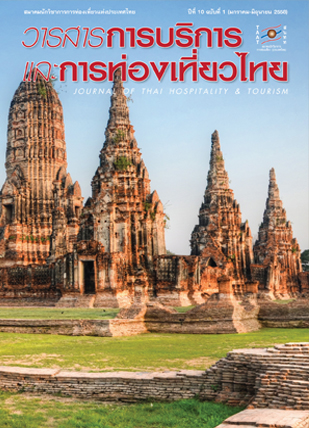Factors Affecting Tourist Experience of Eco, Culture, and Wellness Tourism in the Upper Northern Provincial Cluster 1 of Thailand: Chiang Mai, Lamphun, Lampang, Mae Hong Son
Main Article Content
Abstract
The primary objective of this study was to analyze tourists’ behavior and the factors affecting their experiences of eco, culture, and wellness tourism activities throughout the Thai upper north provincial cluster 1, including Chiang Mai, Lamphun, Lampang and Mae Hong Son Provinces. Data was collected into 2 phrases. At the first phase, the qualitative data was collected from 24 Thai and international tourists by an in-depth interview. The contents analysis were used to analyze an in-depth interview data and the result revealed that there were 10 components to create experiences for tourists including (1) accommodation (2) activities (3) environment (4) local transportation (5) value for money (6) tour guide (7) tourism information center (8) food and beverage (9) safety and (10) attraction. The result of an in-depth interview was used to develop questionnaires and collected quantitative data from tourists who visited the study area in the second phrase. A quantitative questionnaire was collected from three hundred Thai tourists and three hundred international tourists who visited this study area. The data were analyzed using descriptive statistics and regression analysis techniques. This data revealed that tourists grouped clearly into four categories and of those who enjoyed; (1) a combination of eco, culture, and wellness tourism activities; (2) a combination of eco and cultural tourism activities (especially Thai boxing and Thai culinary-related). It is notable that these activities were prominently desired by international tourists; (3) a combination of culture and wellness tourism activities, with health spa-related activities as the most attractive; and (4) the tourists who enjoyed only culture tourism activities. Considering the standardized coefficients beta from regression linear analysis, it was found that the factors affecting on the international tourists’ experiences were primarily related to the natural environment and the overall atmosphere of the destinations, as well as perceived value for their money, quality of tourism activities and tour guides, respectively. As for the factors affecting Thai tourists’ experiences, they are the perceived value for their money, quality of tourism information center(s), accommodation, local transportation, as well as overall atmosphere and natural environment of the destinations, respectively. Moreover, it was found that the lowest satisfaction score for both Thai and international tourists was placed on the quality of local transportation service; these factors include comfort and reliability, safety, quality of services, and price, in comparison to the other factors. Thus, all of these factors should be considered in order to generate high-quality tourism experiences, and all organizational stakeholders should improve the local transportation service to increase tourists’ satisfaction levels.
Article Details
References
[2] กรมการท่องเที่ยว. (2554). สรุปสถิติการท่องเที่ยวประเทศไทยปี 2553. วันที่ค้นข้อมูล 18 พฤษภาคม 2555, จาก กรมการท่องเที่ยว http://tourism.go.th/2010/upload/filecenter/file/stat_2554.
[3] บุษบา สุธีธร และภัสวลี นิติเกษตรสุนทร. (2541). เจตคติและความประทับใจของชาวต่างประเทศที่ได้มาเยี่ยมประเทศไทย. กรุงเทพฯ: สํานักงานคณะกรรมการวัฒนธรรมแห่งชาติกระทรวงศึกษาธิการ.
[4] ปราณี เอี่ยมลออภักดี. (2548). การตลาดประสบการณ์:ประสบการณ์ของลูกค้า. วารสารวิชาการมหาวิทยาลัยหอการค้าไทย, 25(2), 19-28.
[5] ฐิติศักดิ์ เวชกามา. (2557). การท่องเที่ยวเชิงสร้างสรรค์: การเตรียมความพร้อมการท่องเที่ยวไทย. วารสารการบริการและการท่องเที่ยวไทย, 9(1), 64-77.
[6] ศิวฤทธิ์ พงศกรรังศิลป์. (2547). หลักการตลาด. กรุงเทพฯ: บริษัทสํานักพิมพ์ท้อป.
[7] สํานักงานสถิติแห่งชาติ. (2555). สรุปสถานการณ์ท่องเที่ยวภายในประเทศ พ.ศ. 2552–2553. วันที่ค้นข้อมูล 20 มิถุนายน 2555, จาก สํานักงานพัฒนาการท่องเที่ยว http://service.nso.go.th/nso/nsopublish/BaseStat/basestat.html.
[8] สํานักงานพัฒนาการท่องเที่ยว. (2553). รายงานฉบับสมบูรณ์โครงการสํารวจพฤติกรรมการเดินทางของนักท่องเที่ยวภายในประเทศ. วันที่ค้นข้อมูล 20 มิถุนายน 2555, จาก สํานักงานพัฒนาการท่องเที่ยว http://tourism.go.th/2010/th/statistic/tourism.php?cid=27.
[9] สิน พันธุ์พินิจ. (2553). เทคนิคการวิเคราะห์ทางสังคมศาสตร์. กรุงเทพฯ: บริษัทวิทยพัฒน์จํากัด.
[10] สํานักบริหารยุทธศาสตร์กลุ่มจังหวัดภาคเหนือตอนบน 1. (2557). แผนพัฒนากลุ่มจังหวัดภาคเหนือตอนบน 1 (พ.ศ.2557-2560). วันที่ค้นข้อมูล 20 กุมภาพันธ์ 2557, จาก บัณฑิตวิทยาลัยมหาวิทยาลัยเชียงใหม่ http://www.grad.cmu.ac.th/th/files/NorthernThailandStategy.
[11] อรช รมณีสงฆ์, นฤมล กิมภากรณ์ และธันยา พรหมบุรมย์. (2553). พฤติกรรมของนักท่องเที่ยวชาวไทยต่อการท่องเที่ยวภาคเหนือตอนบนของประเทศไทย. เชียงใหม่: คณะบริหารธุรกิจมหาวิทยาลัยเชียงใหม่.
[12] Brodie, R. J., Whittome, J. R. M. & Brush, G. J. (2008). Investigating the service brand: A customer value perspective. Journal of Business Research, 62(3), 345-355.
[13] Canadian Tourism Commission. (2013). Australia Market Profile. วันที่ค้นข้อมูล 20 มิถุนายน 2555, จาก http://encorporate.canada.travel/sites/default/files/pdf/Research/Market-knowledge/Market-profile/Australia/au_market_profile_2013.
[14] Philip, K. & Keller, K. L. (2012). Marketing management. New Jersey: Pearson Education.
[15] IncReichheld, F. & Markey, R. (2011). The Ultimate Question 2.0: How Net Promoter Companies Thrive in a Customer-Driven World. Boston: Harvard Business Review Press.
[16] Sampson, P. M. J. (1967). Commonsense in qualitative research. Journal of the Market Research Society, 9(1), 30-38.
[17] Schmit, B. (1999). Experiential marketing. Journal of Marketing Management, 15, 53-67.
[18] Smit, E., Bronner, F. & Tolboom, M. (2007). Brand relationship quality and its value for personal contact. Journal of Business Research, 60(6), 627-633.


